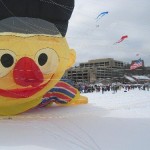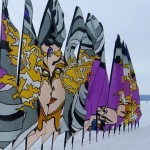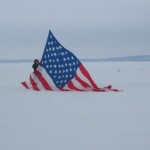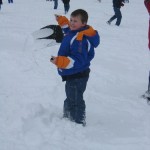 Kites On Ice ….. Every time Susie and I step off the airplane in Madison Wisconsin and that rush of cold air hits us in the face, we look at each other and wonder aloud — what on earth are we doing here when we could be warm and safe back in Oregon??
Kites On Ice ….. Every time Susie and I step off the airplane in Madison Wisconsin and that rush of cold air hits us in the face, we look at each other and wonder aloud — what on earth are we doing here when we could be warm and safe back in Oregon??
 KOI is a demanding, punishing, and intensely physical event. The frozen lake is hard to walk on and of course, slippery. The snow is worse than slogging through soft sand. Turbulent winds make flying a challenge. Thick clothing inhibits every movement. And the cold saps all your energy.
KOI is a demanding, punishing, and intensely physical event. The frozen lake is hard to walk on and of course, slippery. The snow is worse than slogging through soft sand. Turbulent winds make flying a challenge. Thick clothing inhibits every movement. And the cold saps all your energy.
So why do we keep coming back??
The simple answer is that we have great fun! But it is really more than that. The Madison organizers clearly appreciate all of us and treat us really well. Lodging, meals, parties, transportation and support are all top-notch. Volunteers help out wherever or whenever you need them. The event even gives you beer or ice-cream vouchers!
The crowds are spectacular. On Saturday, local authorities said there were 45,000 people on site. It was cold and snowy and slippery, but they came anyway and the only thing there to see was us! That makes Kites on Ice one of the largest attendance kite events in North America.
The program works as well as anything I’ve seen. On the ice, you have art kites and sport kite shows, framed with larger showpieces. Indoors, you have workshops for kids, kitemaking programs, and even scientific symposiums like “The Physics of Ice”. And you also have indoor flying exhibitions and teaching programs.
And finally but most important, you have lots of warm friends and the largest collection of sponsored fliers for any event in America. Overseas kiters came from Japan, Colombia, Germany, Austria and Switzerland. Dozens of other fliers, artists, and performers came from around the USA and Canada. And of course, plenty of local talent joined us on the ice or inside the Union.
 For 2004, KOI moved to a new location — from the Terrace on Lake Menona to the campus on Lake Mendota. (How do they keep those names straight anyway??)
For 2004, KOI moved to a new location — from the Terrace on Lake Menona to the campus on Lake Mendota. (How do they keep those names straight anyway??)
Extended cold meant the ice was thicker than normal. That means harder, colder, and more difficult to anchor in. Fresh snow coated everything.
Saturday we had smooth light winds off the ice but Sunday, the breezes turned and came in over the building and hills. We shifted ice anchors 200 yards out onto the lake looking to avoid the turbulence but never really succeeded. Kites were up and down all day. That means we never really got a chance to go inside and rest, warm up, or check out the “workshop weenies”.
It’s fun to tease the fliers who work up a sweat indoors when it is bitter cold on the flying field. But the truth is that they worked hard in there pleasing thousands of guests and doing jobs I’d prefer to pass on.
 So instead of being warm and cozy, close to the food and toilets and dressed in shorts and tee shirts, Susie and I passed our time shivering, dodging wild children, and earning wind burns out on the ice.
So instead of being warm and cozy, close to the food and toilets and dressed in shorts and tee shirts, Susie and I passed our time shivering, dodging wild children, and earning wind burns out on the ice.
Fields were better marked this year and we had little problem with people walking through the barriers. But when we moved downwind Sunday, security became a larger problem. The day ended with the Giant Cat being cut down by an unattended delta.
KOI is always an adventure. Part of the fun is telling people what it was like and bragging that you survived. We especially enjoyed flying with Al Sparling, Mike Agner, Gary Engvall, Kurt Lisk, Bob Rymaszewski, Greg Rasberry and Toby Schlick out on the big kite field.
Bottom line — we’ll be back next year for KOI #7. By then, we will have thawed out a bit and be ready to test our endurance again.















